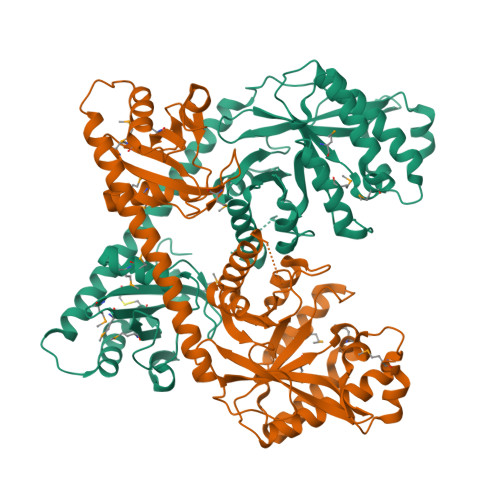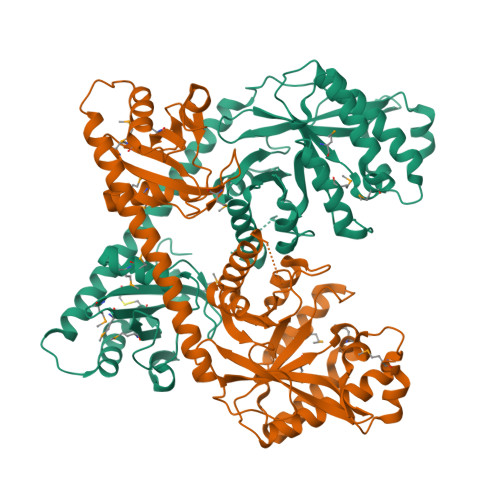Crystal structures of YkuI and its complex with second messenger cyclic Di-GMP suggest catalytic mechanism of phosphodiester bond cleavage by EAL domains.
Minasov, G., Padavattan, S., Shuvalova, L., Brunzelle, J.S., Miller, D.J., Basle, A., Massa, C., Collart, F.R., Schirmer, T., Anderson, W.F.(2009) J Biological Chem 284: 13174-13184
- PubMed: 19244251
- DOI: https://doi.org/10.1074/jbc.M808221200
- Primary Citation of Related Structures:
2BAS, 2W27 - PubMed Abstract:
Cyclic di-GMP (c-di-GMP) is a ubiquitous bacterial second messenger that is involved in the regulation of cell surface-associated traits and the persistence of infections. Omnipresent GGDEF and EAL domains, which occur in various combinations with regulatory domains, catalyze c-di-GMP synthesis and degradation, respectively. The crystal structure of full-length YkuI from Bacillus subtilis, composed of an EAL domain and a C-terminal PAS-like domain, has been determined in its native form and in complex with c-di-GMP and Ca(2+). The EAL domain exhibits a triose-phosphate isomerase-barrel fold with one antiparallel beta-strand. The complex with c-di-GMP-Ca(2+) defines the active site of the putative phosphodiesterase located at the C-terminal end of the beta-barrel. The EAL motif is part of the active site with Glu-33 of the motif being involved in cation coordination. The structure of the complex allows the proposal of a phosphodiesterase mechanism, in which the divalent cation and the general base Glu-209 activate a catalytic water molecule for nucleophilic in-line attack on the phosphorus. The C-terminal domain closely resembles the PAS-fold. Its pocket-like structure could accommodate a yet unknown ligand. YkuI forms a tight dimer via EAL-EAL and trans EAL-PAS-like domain association. The possible regulatory significance of the EAL-EAL interface and a mechanism for signal transduction between sensory and catalytic domains of c-di-GMP-specific phosphodiesterases are discussed.
Organizational Affiliation:
Department of Molecular Pharmacology and Biological Chemistry and Midwest Center for Structural Genomics, Northwestern Feinberg School of Medicine, Chicago, IL 60611, USA.




















